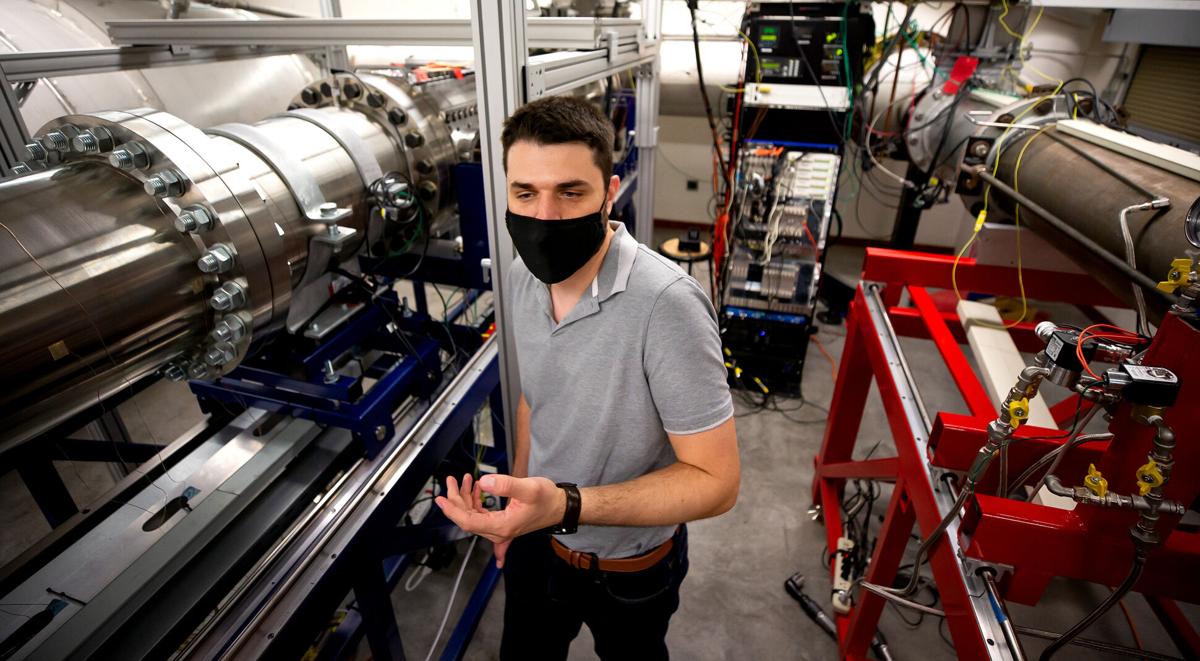A University of Arizona research team has won a $1.5 million federal defense grant to advance tools to design hypersonic aircraft in partnership with Tucson-based Raytheon Missiles & Defense.
The grant was part of $25.5 million awarded in the first round of funding by the University Consortium for Applied Hypersonics for 18 university-led projects that advance the field of hypersonic flight, in which vehicles travel upwards of five times the speed of sound.
Samy Missoum, a professor of aerospace and mechanical engineering at the University of Arizona, received $1.5 million to lead the development of a “surrogate aerodynamic database” as an essential tool in the design of next-generation hypersonic systems.
The UA researchers plan to use machine learning — a form of artificial intelligence — and statistical techniques to develop a database of aerodynamic data. That will allow researchers to predict the behavior of a hypersonic vehicle without the need to run a wind tunnel experiment or an expensive computer simulation.
Co-investigators from the UA Department of Aerospace and Mechanical Engineering are Alex Craig and Jesse Little, who specialize in wind tunnel experiments, and Kyle Hanquist and Hermann Fasel, who specialize in hypersonic simulations. Michael Chertkov, chair of the UA’s Program in Applied Mathematics, will provide expertise in physics-informed machine learning.
The UA team is also partnering with Raytheon, which is developing hypersonics for the military to counter moves by China and Russia to develop their own hypersonic missiles.
The UA is among 87 university members of the University Consortium for Applied Hypersonics, which was launched by the Defense Department last year to develop the workforce and research for modern hypersonic flight systems in support of national defense. The consortium also has 90 industry partners, including Raytheon, and eight national laboratories.
Wes Kremer, president of Raytheon Missiles & Defense, said the company’s involvement in the university consortium will help develop the next generation of hypersonic engineers.
“Our investment in digital engineering tools like the surrogate aerodynamic database will accelerate the development and delivery of hypersonic technologies to the warfighter,” Kremer said as part of the UA’s grant announcement.
Next-gen interceptor advances
Tucson-based Raytheon Missiles & Defense marked major milestones in its venture with Northrop Grumman to develop the nation’s next ballistic-missile interceptor.
Northrop and Raytheon announced last week that the U.S. Missile Defense Agency had approved a jointly developed software-development system and related digital infrastructure the companies will use in designing the Next Generation Interceptor, or NGI.
Northrop Grumman’s Chandler-based launch and missile-defense division — the former rocket-making operations of Orbital ATK, which Northrop acquired in 2018 — is leading the NGI effort.
Northrop and Raytheon are competing against a team led by Lockheed Martin to develop the NGI, which is planned to replace the ground-based, long-range interceptors now deployed in silos in California and Alaska as part of the Boeing-led Ground-based Midcourse Defense system.
Melissa Morrison-Ellis, deputy program director for the NGI at Raytheon, said the companies are rapidly developing their preliminary design in a “model-based environment.”
“This digital ecosystem accelerates the software development timeline, ensuring that warfighters are equipped with defensive interceptors that protect the U.S. from the threat of a rogue missile strike,” Morrison-Ellis said in a news release.
Problems with a Raytheon “kill vehicle” — essentially, a non-explosive warhead designed to destroy a target missile by sheer impact — prompted the Missile Defense Agency to initially launch an effort to develop a redesigned kill vehicle and later, an entirely new interceptor with the NGI.
In March, Northrop Grumman’s Chandler-based division was awarded a contract worth up to $3.9 billion, including options, to develop NGI technology through March 2026.
Defense rival Lockheed Martin and Aerojet Rocketdyne, which partnered on its NGI bid with rocket-engine maker Aerojet Rocketdyne, was awarded a similar contract worth up to $3.7 billion.
Meanwhile, Raytheon also announced last week that it had successfully completed a key, early engineering test of the thruster valve and nozzle on a liquid-propellant rocket system designed by Aerojet to control the NGI’s kill vehicle.
Aerojet, which makes rocket engines used on all of the MDA’s missile interceptors, is the target of a controversial planned buyout by Lockheed Martin.
The deal has been vehemently opposed as anti-competitive by Raytheon, which pointed out in its NGI test news release that Aerojet “has been a supplier for Raytheon Missiles & Defense across numerous missile defense programs for 20 years.”
Lockheed’s bid for Aerojet is the subject of a pending antitrust review by the Federal Trade Commission.
Sion partners with Cummins
Tucson-based Sion Power announced an agreement with Cummins Inc. to design and supply its proprietary lithium-metal battery cells to the major truck-engine maker as it moves to develop and market electric powertrains.
In connection with the agreement, Indiana-based Cummins made an undisclosed investment in Sion Power, the Tucson company said.
Under the deal, Sion will launch a multi-year development program to design and supply large-format, lithium-metal battery cells for use in Cummins battery packs, which will be integrated in its electric powertrains for commercial vehicles.
Sion says its Licerion lithium-metal batteries contain twice the energy in the same size and weight battery compared with a traditional lithium-ion battery.
With students back at UA for the fall semester, here's a look at the Tucson campus over the years compared to now.





